Go World Travel is reader-supported and may earn a commission from purchases made through links in this piece.
While many know of Rome, Milan, Naples, and the enchanting Amalfi Coast, today I want to introduce you to an extraordinary destination located in the “heel” of Italy’s “boot”—Alberobello, Italy’s hidden gem.
This unique town is famous for its trulli houses—charming limestone buildings with conical roofs, striking white facades, and colorful cacti. The narrow streets hold a captivating history, including one of the most intriguing tax evasion tactics you’ll ever hear about, which we will delve into later.
Situated in southern Italy’s Apulia (Puglia) region, Alberobello lies between the cities of Brindisi and Bari.
Italy shares borders with several popular European countries including Austria, Switzerland, Slovenia, France, San Marino, and the Vatican, making it easy to combine your visit with neighboring attractions.
The currency used is the euro and the official language is Italian. While English is commonly spoken, knowing the phrase “che bello” (how beautiful) is a nice touch, as it’s often used in conversation.
Italy is also blessed with the stunning Adriatic Sea, so it’s safe to say, “Italy is always a good idea.” Enjoy this Alberobello travel guide and ensure you have your passport ready.
Trulli Houses: A Clever Way to Avoid Taxes
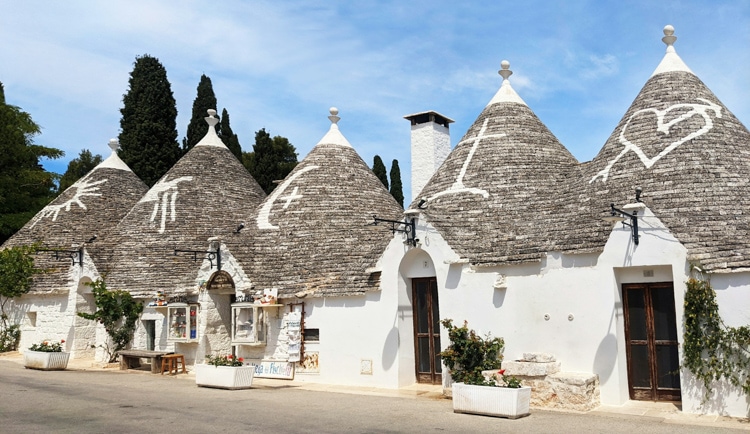
Believe it or not, Alberobello owes its existence to humanity’s timeless desire to dodge taxes.
The town’s primary tourist attractions are its remarkable trulli, built without cement or plaster from limestone, using a drywall technique for sturdy construction. The roofs often feature various symbols representing good luck, both religious and superstitious in nature.
The key advantage of trulli houses was their flexibility; they could be easily taken apart and reassembled. During the Kingdom of Naples, locals would dismantle their homes before tax collectors arrived and then rebuild them afterward. Isn’t that a clever form of tax evasion? The history of Alberobello is indeed fascinating.
Stay in a Trullo: An Architectural Marvel
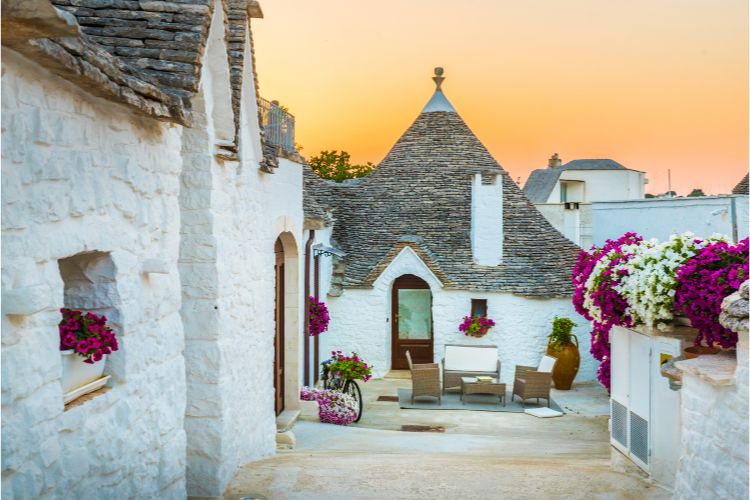
Yes, you can book a stay in a trullo (singular; trulli is plural). It’s not only a charming experience but also allows you to say you slept in a true architectural wonder.
These unique dwellings have survived since the 14th century and were designated as heritage sites by Italy in 1909. Building, demolishing, or creating replicas is prohibited, and any modifications must be authorized. In 1996, Alberobello’s trulli were recognized as a UNESCO World Heritage Site. Interesting enough, they also have natural “air conditioning,” as the thick stone walls keep them cozy in winter and refreshingly cool in summer.
Isn’t it a remarkable place to stay while traveling?
Take an Apulian Cooking Class in a Local’s Home

Is there anything more quintessentially Italian than pasta? Perhaps pizza or espresso, but you get my point.
That’s why I encourage you to roll up your sleeves and sign up for a cooking class. You’ll learn how to make your own pasta—like maccheroni, gnocchi, or orecchiette—under the guidance of local nonnas, all while enjoying a glass of wine or coffee.
Imagine the excitement of your friends when you host a pasta dinner featuring the dishes you learned to make in Italy. If I were your friend, I would definitely want to be invited.
Stroll Through Rione Aia Piccola (Small Yard District)
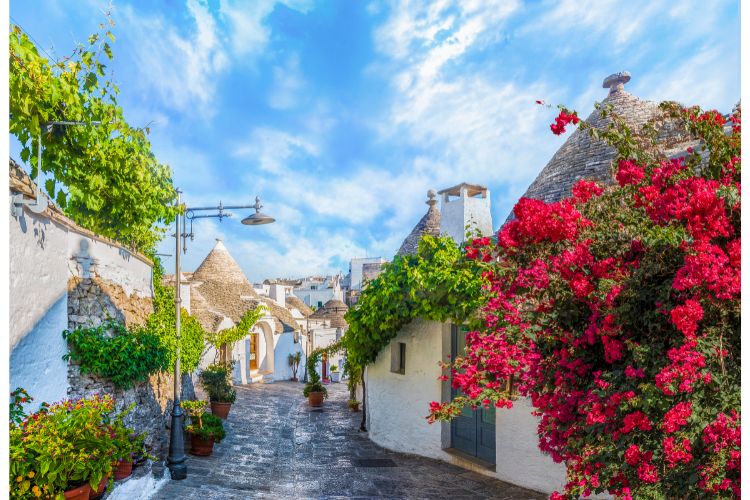
Looking for a less touristy and more authentic experience in Alberobello? Look no further than Rione Aia Piccola.
This tranquil district features 400 trulli, offering a glimpse of Alberobello without the overwhelming presence of tourist shops and restaurants.
This residential area also has rental accommodations, allowing you to immerse yourself in the authenticity of white trulli, pastel-green cacti, and vibrant flowers.
But before leaving Rione Aia Piccola, be sure to do one more thing…
Visit Terazza Belvedere (Santuario di Santa Lucia)
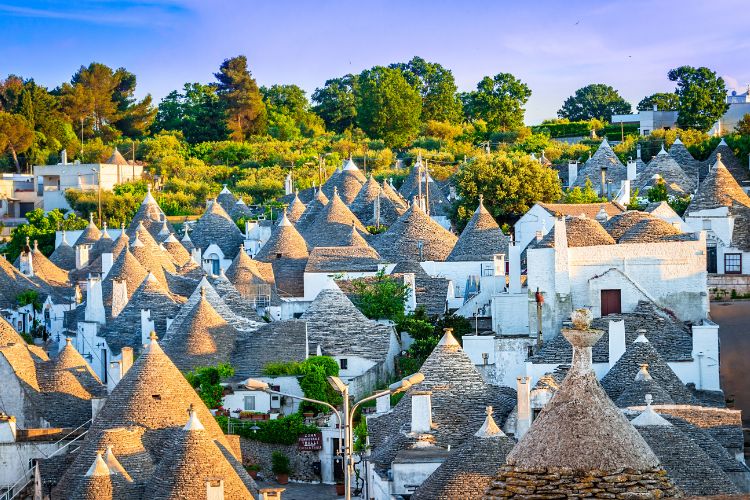
Before leaving Rione Aia Piccola, don’t miss the stunning panoramic view dotted with white facades and gray roofs at Terazza Belvedere, the most famous viewpoint in the area.
Located at the edge of Rione Aia Piccola, the houses visible from here are part of the iconic Rione Monti district, which you will discover next.
After enjoying the breathtaking view, take a stroll down the Stairway of Love (Scalinata dell’Amore), a romantic staircase adorned with hearts and poetic lines. Very Italian, right?
Explore Rione Monti
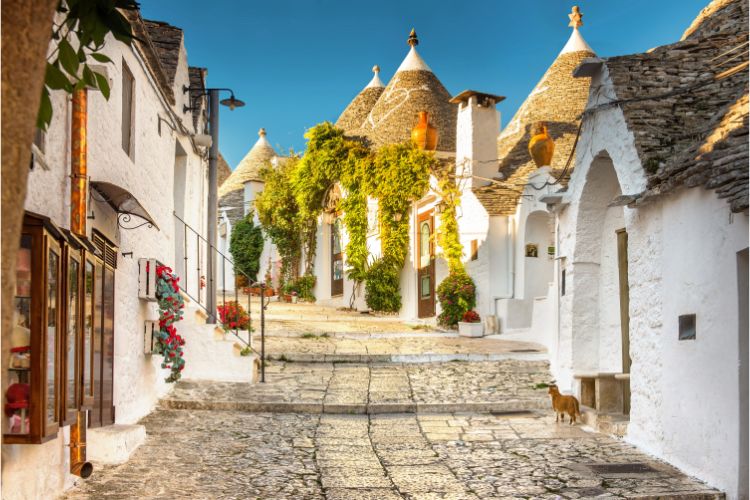
While experiencing the authentic parts of Alberobello is enjoyable, you’ll want to take a leisurely stroll through Rione Monti, where over 1,000 trulli await you, making you feel as if you’ve stepped into Greece instead of Italy.
This historic center is home to the largest crowds of tourists, numerous cafés, and an array of souvenir shops.
Consider scheduling a walking tour to learn more, or simply grab a gelato and explore, which might be the most delightful way to experience Alberobello. After all, all paths lead to the trulli, and that’s the essence of your visit, right?
Visit Trullo Siamese and Discover Its Love Story
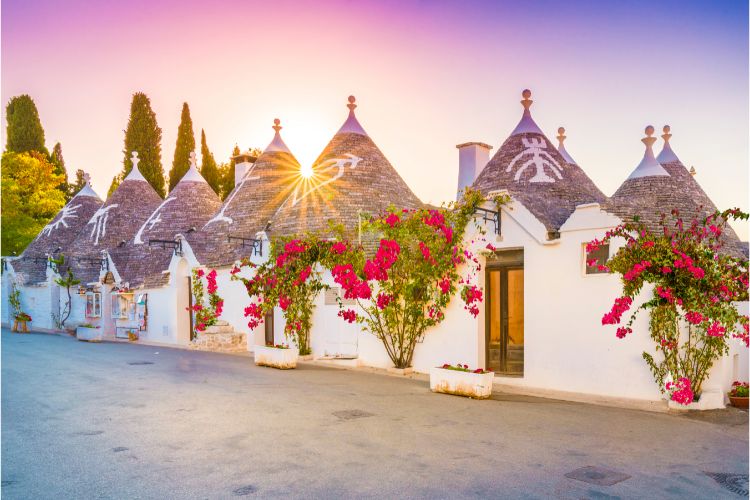
Ah, love—it creates wonders yet can also ignite conflicts. This is the story behind the famous Trullo Siamese.
Splitting into two halves, it’s said that two brothers lived here and both fell in love with the same woman. She chose the younger brother, prompting him to refuse to leave the house that was legally shared. Consequently, the trullo got divided into two parts, with each side featuring its own entrance facing different streets.
This charming legend gives rise to one of the most iconic attractions in town. Visiting is free, but do consider stopping by the gift shop for a little souvenir.
Stop by the Basilica of St. Cosmas e Damiano
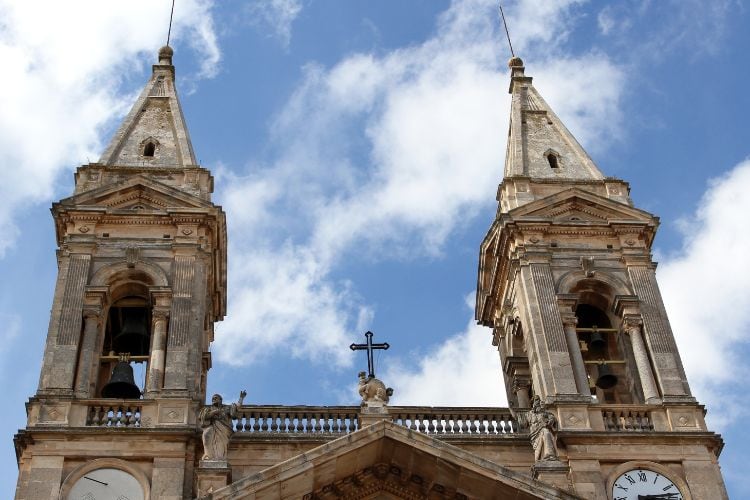
Be sure to visit the Basilica of St. Cosmas and Damiano while in Alberobello. This 17th-century Roman Catholic church features stunning artwork, including beautifully detailed frescoes showcasing scenes from the lives of St. Cosmas and St. Damiano.
You’ll find it easily, standing out with its warm golden-brown hues against the whites of the trulli.
Read More: A Retreat to the Tuscan Oasis of Borgo San Felice, a Medieval Hamlet Turned Resort
Trullo Church of Saint Anthony of Padua (Sant’Antonio)
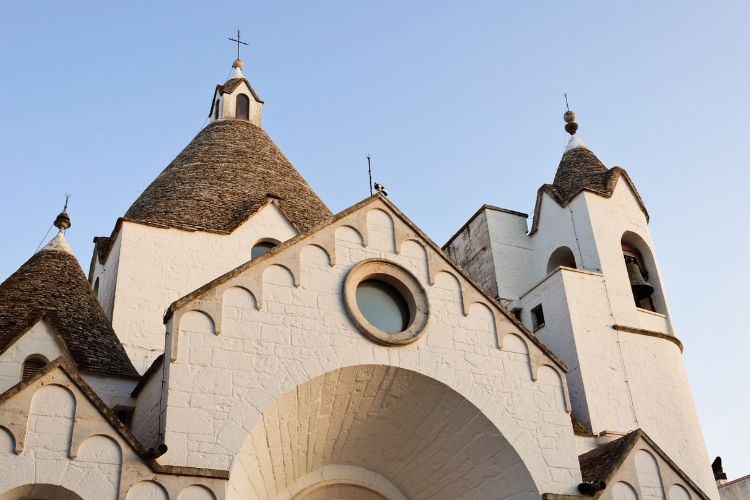
The Church of Saint Anthony of Padua is unique as it is the only trullo church in the world. Fascinating, isn’t it? This church opened in 1927, and due to a prohibition on modern construction in Rione Monti since 1910, it was built in the traditional trulli style.
A visit is definitely worth it, and while you’re there, don’t miss the stunning frescoes adorning the interior.
Explore Trullo Sovrano, the Museum in the Largest Trullo
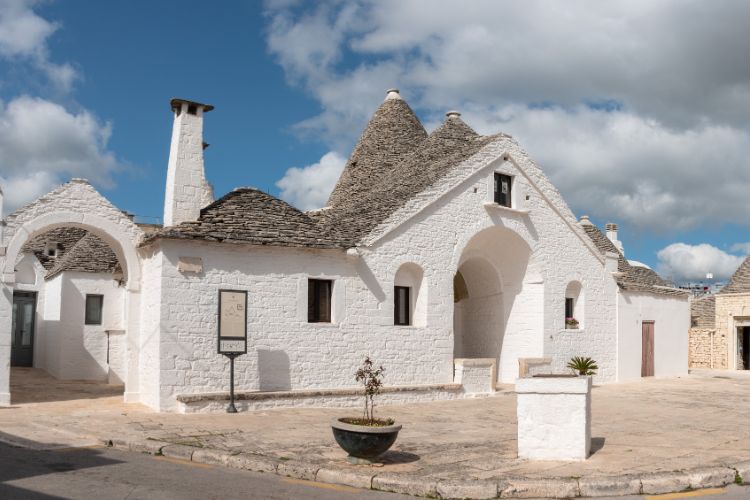
Can you imagine living in a house that could be taken apart at any moment? You don’t have to imagine just visit Trullo Sovrano, the largest trullo in Alberobello.
Once the home of a wealthy priest’s family, it now serves as a museum. For a small fee (about $2-3), you can explore life as it was in the 1800s.
You’ll learn intriguing facts from educational displays and see authentic rooms from that era. How cool is that?
Purchase a Souvenir: From Mini Trulli to Olive Oil
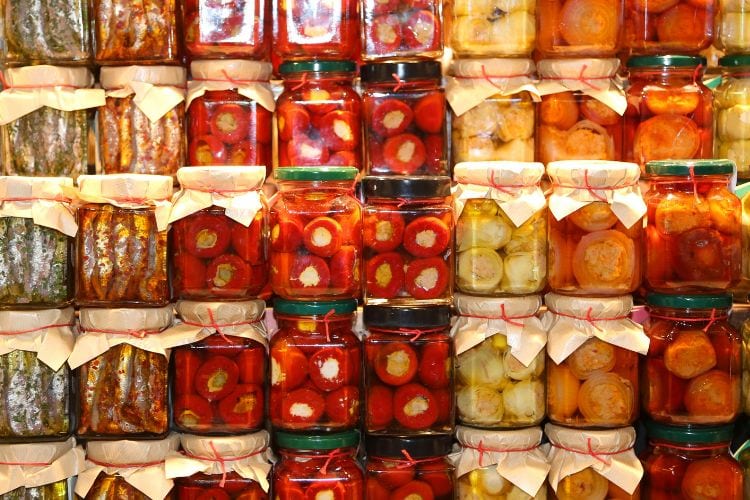
Where there are many tourists, there’s also a plethora of souvenir shops. Mini trulli are highly sought after, but you’ll also find craft markets prevalent during the peak season (April through October).
If you’re interested in food souvenirs, Alberobello is renowned for its high-quality olive oil, fantastic local wines, and delicious honey.
Don’t forget to explore the clothing boutiques; Italians excel in fashion as much as they do in cuisine.
Check Out Casa d’Amore
Another must-see is Casa d’Amore, the home of Francesco d’Amore, a pivotal figure in Alberobello’s history who played a significant role in ending feudal tyranny.
Built in 1797, this tourist attraction is notable for being the first building in the area not constructed in the trulli style, featuring plaster and measuring two floors high.
It received the distinction of being a national monument in 1930. While it may blend in, make sure you don’t miss it.
Savor Traditional Puglian Cuisine

Pugliese orecchiette pasta, burrata cheese (maybe with truffles?), panna cotta, focaccia, local wines, Pasqualino sandwiches (filled with tuna, capers, salami, and cheese), and some of the finest olive oil in Italy—no doubts about it, you won’t leave hungry.
For a truly unique dining experience, arrange a meal hosted by a local family, allowing you to savor homemade dishes in a warm, inviting atmosphere.
Watch how an Italian elegantly places homemade pasta onto your table while saying Bon Appetit with genuine charm.
Read More: Blissful Mountain Escape at ADLER Spa Resort DOLOMITI in the Italian Alps
Ideal Day Trips: Locorotondo, Martina Franca, or Matera
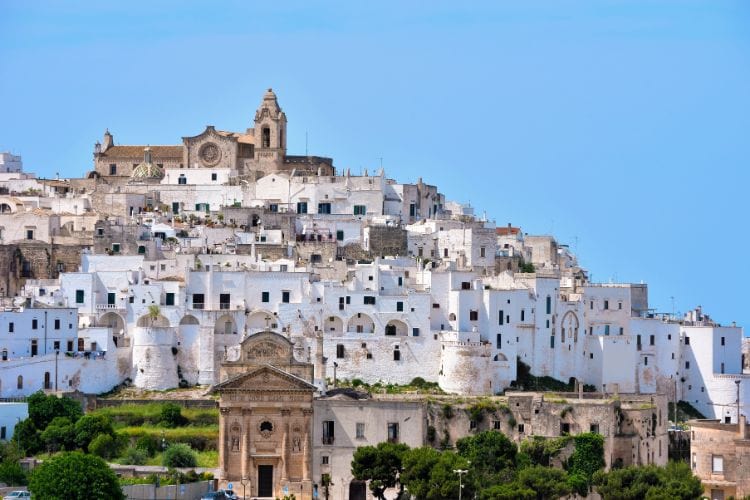
Need a break? Take a road trip to Polignano a Mare (just 29 kilometers away) for a refreshing swim in the Adriatic Sea, framed by stunning cliffs rising 24 meters into the air.
If you can’t get enough of the white-washed facades, consider a day trip to picturesque Ostuni (43 kilometers away), where the charming buildings contrast beautifully with the deep blue waters of the Adriatic Sea.
Monopoli (19 km away) is also worth a visit, with its whimsical pastel white architecture; plan for a full day here (though you might want to stay longer). Further afield is beautiful Locorotondo (8 km away) in the Itria Valley, famous for its stunning white scenery.
If you’re captivated by this style, a day trip to Martina Franca (12 km away) is recommended. For something distinct yet similar, Matera (69 kilometers away) is a magical destination well worth the journey.
If you enjoy indulging like the Italians, consider booking a guided tour of Valle d’Itria’s wineries. Because, as they say in Italy, “dolce far niente!”
Read More:





